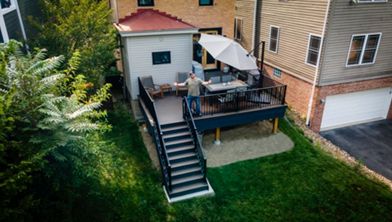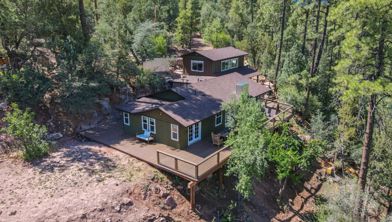Myths, Busted: The Truth About Composite Decking
Myths about composite decking busted! Get the facts on heat, cost, scratch, slip, fade, warp, and more for a better decking choice.
When it comes to decking, outdated information can lead to confusion for consumers—especially regarding composite materials. Many of the myths surrounding composite decking originate from the product’s early days in the 1990s, but significant advancements have transformed these misconceptions into old news.
There have been considerable engineering enhancements made to composite decking since it was first introduced. As a result, today’s modern composites offer improved durability an aesthetic that easily outperform traditional wood decking. With features that also address fading, staining, and mold, it’s no wonder so many homeowners are making the switch.
Let’s set the record straight and debunk some of the most common myths about composite decking!
Myth #1: Composite Decking is Not Environmentally Friendly
A widespread misconception is that composite decking isn’t eco-conscious, with people assuming it has a larger environmental impact than natural wood. However, this belief ignores the downsides of wood decking, such as deforestation and the use of chemical treatments that make wood difficult to recycle and dispose of.
Trex shatters this myth with our long-standing commitment to sustainability. In fact, not a single tree has ever been cut down to make our high-performance eco-friendly composite decking. Instead of using virgin wood, the wood material used in our products is all reclaimed.
So, is composite decking environmentally friendly? Here are some fast facts that prove composite materials from Trex are the greenest choice for decking:
- 95% Recycled Content: All Trex decking is made from up to 95% recycled materials, including reclaimed wood and plastic waste, such as grocery bags and newspaper sleeves.
- Annual Waste Repurposing: Every year, Trex repurposes more than 1 billion pounds of waste plastic and wood particles to create durable, eco-friendly decking.
- Massive Recycling Efforts: Since our founding, Trex has recycled over 5.5 billion pounds of plastic film, diverting these materials from landfills and waterways.
- Non-Toxic Products: Consumers, especially those with children and pets, may worry…is composite decking toxic? Engineered with an integrated protective shell, Trex composites do not release toxic compounds into the environment and are safe for eco-sensitive uses. The material is so gentle on its surroundings that homeowners can confidently use the boards to construct a garden bed with Trex decking.
- Environmental Leadership: As a proud member of the U.S. Green Building Council (USGBC), Trex works with industry leaders to promote environmentally and socially responsible building practices.
In addition to these impressive sustainability efforts, we strive to minimize our energy use, water consumption, waste and emissions by prioritizing efficiency and circularity principles in our manufacturing processes. As a prime example, nearly all production scrap is incorporated back into the process – all further reducing our environmental footprint. So, the bottom-line answer to the question, “Is composite decking sustainable?” is a resounding yes. And, when you choose Trex decking, you're opting for a decking material that not only delivers on durability but also makes a positive impact on the planet.
Myth #2: Composite Decking is Too Hot to Use in Summer
Another common myth is that composite decking becomes intolerably hot in warm weather, making it uncomfortable to walk on with bare feet. While it’s true that any material exposed to direct sunlight will experience an increase in temperature, is composite decking heat-resistant? Many consumers are surprised to learn that modern composite decking has made significant strides in reducing heat retention.
For example, Trex offers boards in two decking lines that feature heat-mitigating properties engineered into the shell of the boards. This innovative technology reflects UV rays to keep the surface of the deck boards cooler* than other composite offerings of a similar color. This “cool” feature can be found in our Trex Transcend® Lineage® line and the newest additions to our Trex Enhance® collection – Honey Grove (a warm shade with streaks of browns, greys, and onyx black) and Tide Pool (an airy light grey).
Color choice, in general, can make a marked difference when it comes to heat retention. Lighter shades of composite decking tend to reflect sunlight better, keeping the surface temperature lower than darker shades. And, if you plan your deck with strategically placed shaded areas—like pergolas or canopies—you can enjoy a more temperate place to relax or entertain on even the hottest of days.
**Trex decking with heat-mitigating technology can still get hot to the touch when direct sunlight and high temperatures converge for extended periods of time. We therefore recommend shoes, socks, and pet booties, so that you and yours can enjoy living on your deck as much as we’ve enjoyed innovating it.
Myth #3: Composite Decking is Too Expensive
At first glance, composite decking cost may seem higher than that of pressure-treated wood, leading some homeowners to wonder if it’s worth the investment. However, this myth doesn’t account for the long-term costs associated with maintaining a wood deck. Wood requires regular upkeep, including sanding, staining, and sealing to keep it in good shape. The materials required for these maintenance tasks can add up to hundreds of dollars annually.
In contrast, composite decking requires little maintenance. Composite decking never needs to be stained or sealed, and you won’t have to worry about refinishing or replacing worn-out boards. According to HomeAdvisor.com, maintaining a wood deck can cost anywhere from $540 to $1,050 annually, while composite decking may only require $15 to $20 in yearly upkeep. Over the lifetime of your deck, that adds up to significant savings.
Since it requires less care, and also reduces environmental impact, a composite deck can add more value to your home. According to the 2023 “Cost vs. Value Report” from Remodeling magazine, the addition of a composite deck with an average project cost of $23,430 will recoup 39.8% of that initial investment at sale. It’s no wonder more and more homeowners are choosing composites for their deck projects.
Additionally, when you consider that materials account for just one-third of a deck's total cost—if you're hiring a contractor—opting for composite decking makes even more financial sense. With durable, budget-friendly composite decking lines like Trex Enhance®, you can enjoy all the benefits of composite decking without breaking the bank.
Homeowners curious about whether the deck of their dreams fits into their budget may calculate deck costs with a user-friendly tool on the Trex website that allows you to estimate the material cost for a project.
Myth #4: Composite Decking Scratches Easily
Whether from children’s toys or outdoor furniture, wood decking is vulnerable to scratching and gouging. Fluctuating temperatures can also create cracks in wood, as it naturally expands and contracts, and harsh weather like hail or sleet will take its toll.
But is composite decking scratch-resistant? Most of today’s composites are specifically manufactured to be highly durable. Trex Transcend, Trex Transcend Lineage®, and Trex Signature® all offer scratch-resistant surfaces due to their ultra-strong protective shell. Trex Transcend is especially tough and designed to stand up to heavy foot traffic – making it the perfect choice for families, or anyone who enjoys outdoor entertaining.
In addition to the installation of scratch-resistant composite decking, you can further protect the beauty of your outdoor space with a few simple measures, such as:
- Lift – don’t drag – large items, such as furniture or boxes, across the deck’s surface.
- Place furniture pads on the legs of heavier outdoor tables, chairs, and sofas.
- If your furry friends have long nails, clip them regularly.
- Never use a metal rake to remove leaves, sticks, or other debris from your deck.
Myth #5: Composite Decking Looks Fake
Early-generation composite decking looked less than realistic, but design and material innovations have dramatically evolved – and the latest generation of composite boards do a brilliant job at closely mirroring the rich textures and colors of natural wood.
Today’s high-performance composite products offer a more natural appearance than ever before, with realistic wood grain patterns and multi-tonal hues. Subtle color variations within the same board, perfectly replicate the beautiful inconsistencies in natural wood. The Trex color palette includes a selection for every aesthetic – whether you prefer a bold tropical look, a calming coastal vibe, or a subtle neutral that blends effortlessly with any home’s exterior.
In early 2024, Trex set a new standard for superior aesthetics in the composite industry with the introduction of our Trex Signature collection – the first-ever luxury product tier within the wood-alternative decking marketplace. Each board features an elegant grain pattern and a sophisticated matte finish. The collection’s two distinctively designed colors boast variated shading and subtle highlights meant to evoke the natural beauty of America’s coastal islands.
Myth #6 Composite Decking is Prone to Warping
Warping is a concern for anyone choosing decking materials, but it’s an issue that’s largely been resolved with the new generation of composite decking and proper installation methods. Trex products, for example, are engineered to resist warping or bowing. The same cannot be said for wood, which is extremely prone to expansion and contraction with changes in temperature and humidity.
While quality composite materials like Trex are built to resist warping, you should take extra precautions during the installation process. If you’re tackling a do-it-yourself project, follow the instructions carefully to ensure that the deck boards are not placed too closely together. If slight contraction and expansion occur, boards could press against each other and eventually create a warped appearance. It’s also important to ensure your joist spacing is accurate – so that weight distribution is even on all decking boards to prevent bowing.
Myth #7: Composite Decking will Fade and Look Bad
No one wants to fall in love with a decking color only to watch it fade in the sun as the years go by. Wood is extremely vulnerable to the long-term effects of the sun’s rays, but is composite decking UV resistant?
Every Trex board is built with UV protection in its shell to help guard against fading and discoloration, even in the sunniest of climates. Plus, Trex backs up this claim with a 50-year Limited Residential Fade and Stain Warranty on our Trex Transcend, Trex Transcend Lineage®, and Trex Signature collections. This industry-leading warranty ensures that your deck will maintain its beautiful appearance for decades to come, and safeguards the investment you made in your outdoor living space.
Fade-resistance means that – unlike wood – you won’t need to stain every year or two, or paint every 10 years, to extend the life of your deck. Maintaining a veritable “like new” appearance is practically effortless with newer composites.
Myth #8: Composite Decking Will Get Mold and Mildew
Many homeowners planning an outdoor living space worry about the potential for mold growth and wonder is composite decking water resistant? Like with any outdoor surface, mold can develop on decking boards if proper care is not taken. However, composite decking is designed to resist moisture, which is the primary culprit behind mold and mildew. Trex’s latest generation composite boards use a protective shell technology that keeps moisture out, making mold growth less likely than on wood.
When mold does appear, it's easy to remove. While composite decking is refreshingly low-maintenance – and much more hassle-free than wood – it’s still necessary to do some regular basic upkeep. When cleaning a composite deck, a simple soap-and-water routine is all that’s needed on today’s high-performance boards. Use warm, soapy water and a soft bristle scrub brush to remove dirt and debris from surface boards periodically throughout the year. If, however, your deck is made with an early-generation composite material that does not have a protective shell, you’ll also want to use a composite deck cleaning solution to more effectively remove dirt and inhibit mold growth.
Ventilation is another key to the prevention of mold and mildew on any decking material. Adequate air circulation will allow moisture to dry more quickly. So, during the installation process, make certain deck boards are properly spaced apart. If water does end up pooling on your deck, be sure to sweep it off as quickly as possible.
Myth #9: Composite Decking is Not DIY Friendly
If you’ve always assumed that installing a composite deck is too complicated for a do-it-yourselfer, think again! Trex.com provides comprehensive installation guides, how-to videos, and customer support to guide you through the entire process, including:
- DIY Deck Checklist – Make sure you’ve done all the essential prep work and asked all the right questions before getting started.
- Trex Academy – Dive into this one-stop resource of how-to articles and videos that will walk you through each step of the installation process.
- Free Online Deck Design Tool – Design your dream deck, create a shopping list, and download blueprints from the comfort of your home!
Most pros and DIYers, alike, find that installing composite decking is just as manageable as working with wood, and the tools required are nearly identical. However, one very important “pro tip” is to be extremely precise with the placement of joists. Due to composite decking boards being more rigid than wood, variations in joist height may lead to a noticeable unevenness of the deck surface. Should you encounter the issue of uneven joists during installation, you may need to cut away parts that are too high – or install shims where they are too low.
If you’re almost ready to roll up your sleeves and get to work, but need a last dose of confidence and inspiration, check out this incredible DIY deck transformation story and deck restoration Q&A with “DIY Pete” on the Trex website!
Myth #10: Composite Decking Has to Be Built 12” on Center
For safety and structural integrity, it is critical to ensure that joists are properly spaced during decking installation. While spacing guidelines vary based on factors like the deck’s design and the weight it needs to support, many composite decking products – such as Trex – can be installed with joists spaced at 16 inches, if the boards are run perpendicular to the framing. However, if you’re installing the boards diagonally – or on an angle – they must be placed no more than 12” apart. Trex provides detailed installation instructions to help you determine the best layout for your project, and to learn all the details about properly installing deck joists.
Like many myths, these misconceptions surrounding composite decking are outdated and misleading. Today’s composites offer superior durability, improved aesthetics and easy maintenance that make them a smart investment. If you’re looking to create a stunning outdoor living space, be sure to check out Trex’s composite decking lines for a long-lasting outdoor living solution that’s as easy on the environment as it is on your budget. Choose Trex, and enjoy the perfect blend of style, sustainability, and savings!
This content was partially or fully generated by AI and has been reviewed by our team to ensure accuracy and relevance.




































